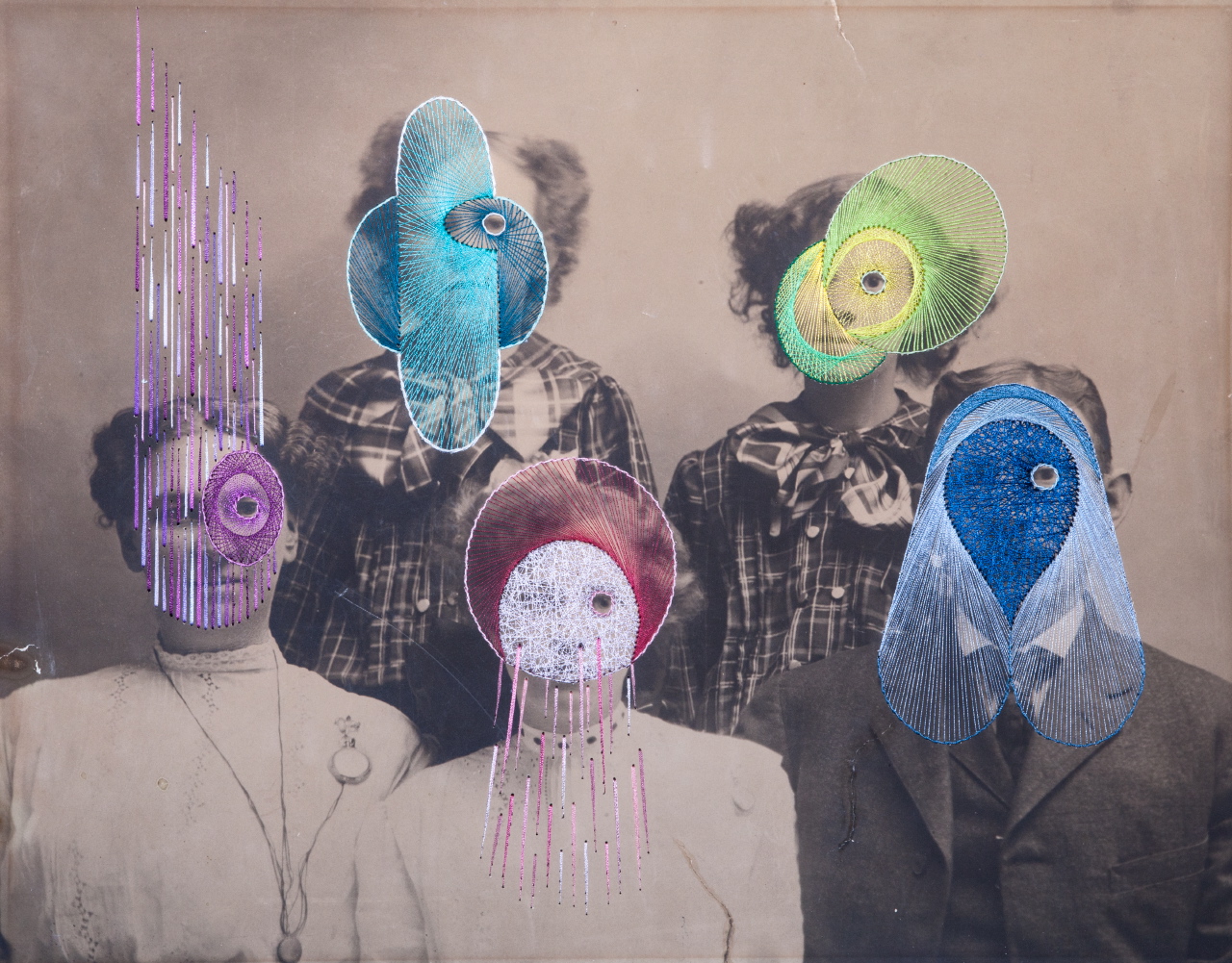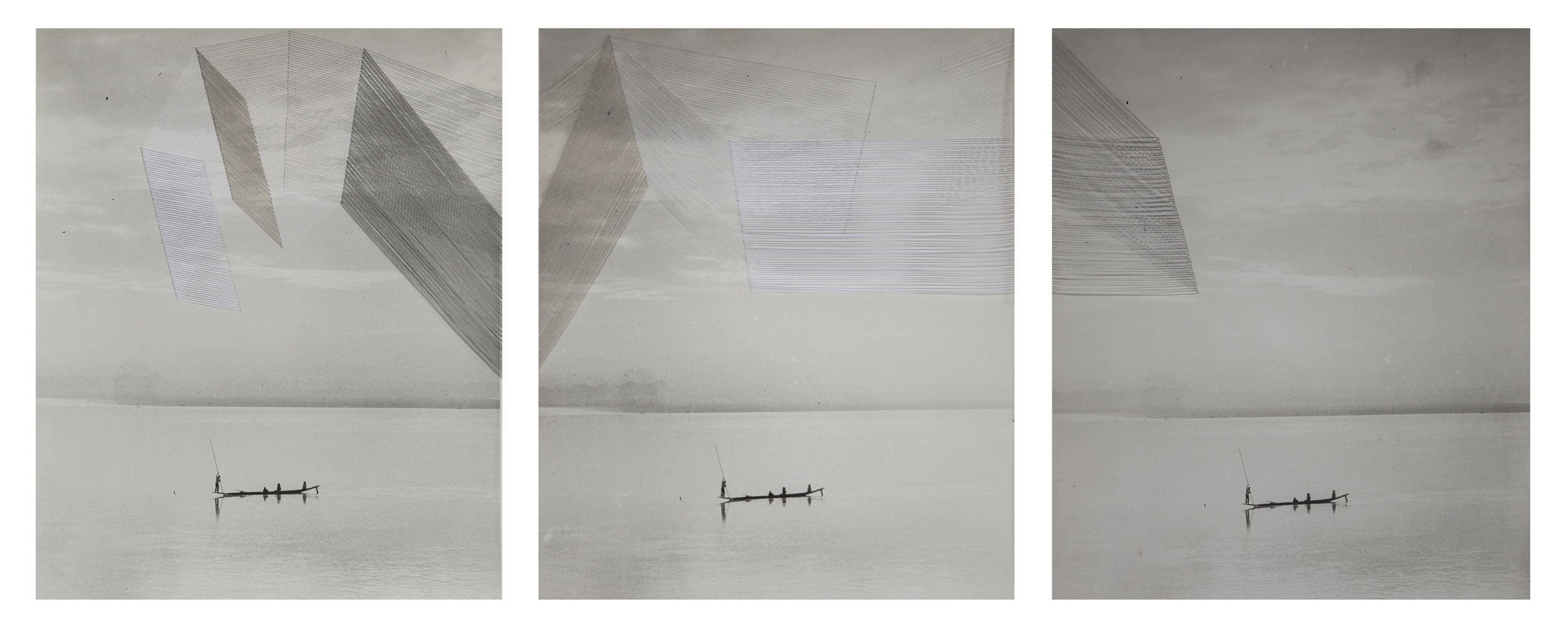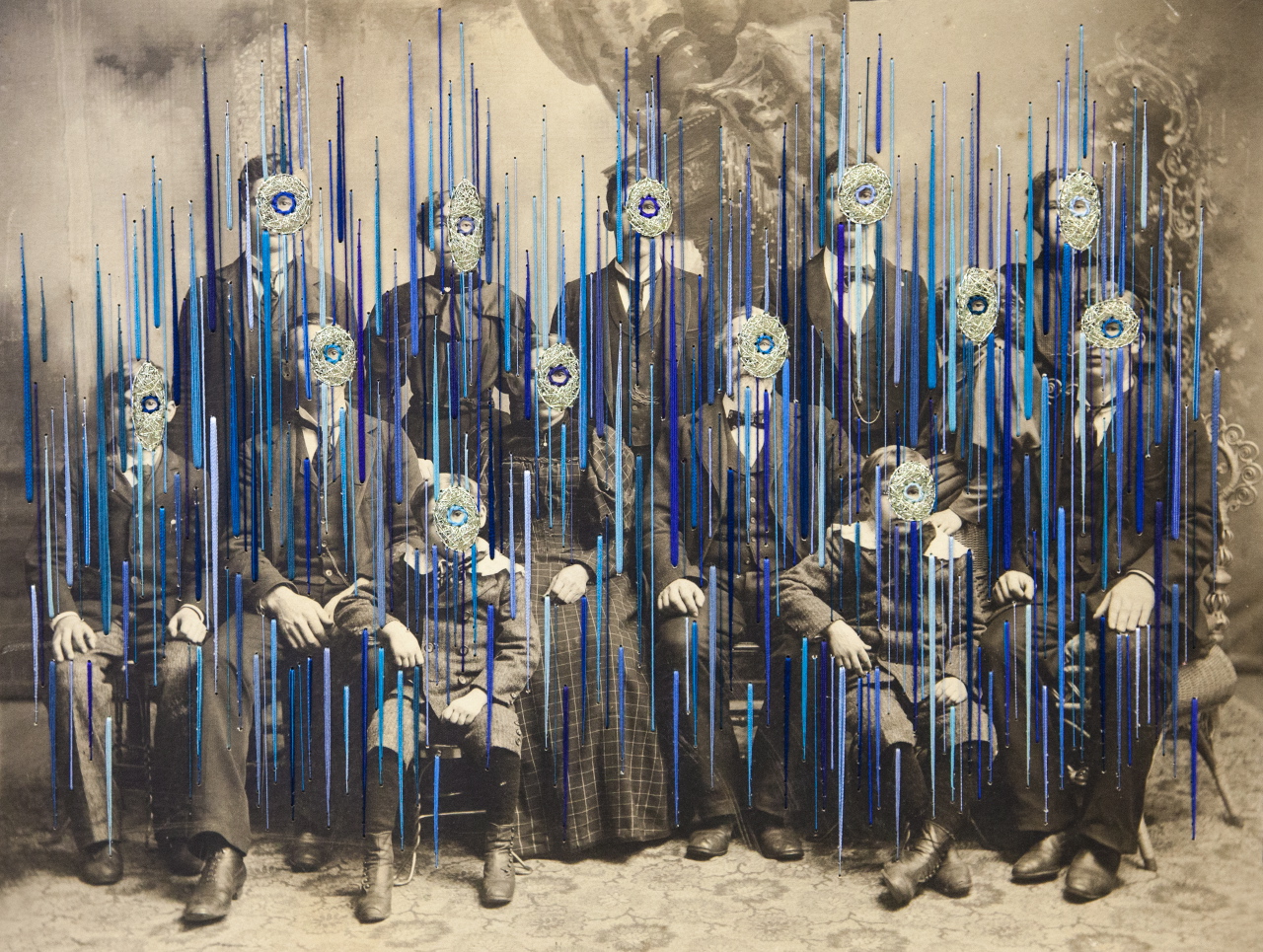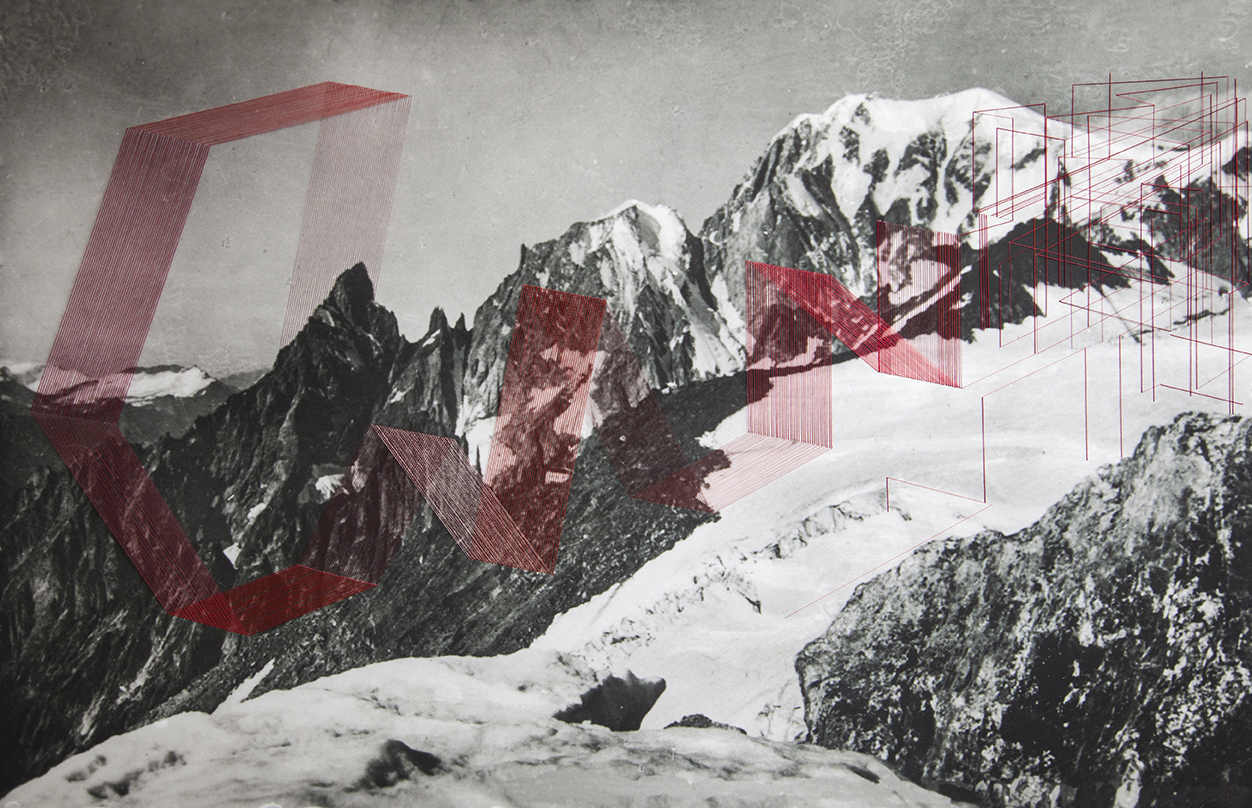

F(faith), 2015, 16×12 inches. Courtesy the artist and Haines Gallery – San Francisco, CA.


The All Family, 2015, 16×20 inches. Courtesy the artist and Haines Gallery – San Francisco, CA.


Pink&Yellow, 2016, 33×47 inches. Courtesy the artist and Haines Gallery – San Francisco, CA.


Ocean, 2016, 33×47 inches. Courtesy the artist and Haines Gallery – San Francisco, CA.


Heavenly Sounds Water, 2015, 19,5×48 inches. Courtesy the artist and Haines Gallery – San Francisco, CA.


Blue Family, 2015, 14×17 inches. Courtesy the artist and Haines Gallery – San Francisco, CA.


AlpsRed, 2016, 33×47 inches. Courtesy the artist and Haines Gallery – San Francisco, CA.
[](https://flaunt-mag.squarespace.com/content/art/qa-maurizio-anzeri#)[](https://flaunt-mag.squarespace.com/content/art/qa-maurizio-anzeri#)
Q&A: Maurizio Anzeri
We talked to contemporary artist Maurizio Anzeri about his work, beauty, and the dynamics of art.
The work of multimedia artist Maurizio Anzeri explores the connection between the soul and the body. Through the use of embroidery, intricately applied to vintage black and white photographs, the artist transforms two-dimensional prints into three-dimensional works of art. This practice, which involves the use of color and design, and the use of applied arts as a drawing tool, allows him to erase the anonymity of the figures, thus hinting to their psychological complexity, inner thoughts, feelings, and overall aura.
Anzeri’s manipulation of photographs has gained the artist international recognition. Since the start of his career, his work has been shown in esteemed museums and galleries around the world, and is held in collections including Saatchi, Gagosian, Rothschild, and the Collection of Alexander McQueen.
Today, Anzeri’s work continues to gain momentum. The series “Heavenly Sounds For Who Draws With Light,” which features landscapes rather than portraits, has recently been included in the Photographer’s Gallery. Moreover Anzeri joins a talented assortment of artists in the group-show ALLURE, which opened on May 27th at C/O Berlin.
We were able to ask Anzeri a few questions regarding his work, beauty, and the dynamics of art.
**Can you tell me about the application of embroidery onto your pieces? How did that begin?**
I come from three generations of fishermen and I have seen men using threads and needles all my life. As a kid I used to spend so much time looking at them repairing and fixing fishing nets on the sea front. Those rituals and meticulous gestures are deeply ingrain in my mind and imagination.
I find amusing that my embroidering has often been understood as an appropriation of techniques traditionally associated to feminine labor.
That is fine by me. I don’t have any problem with this reading of my work. But my first experience of embroidering actually comes from a world of though men doing a very masculine activity. I like somehow this paradox and ambiguity about my use of embroidering.
For me embroidering represents a different way of drawing: with threads rather than pencils. Like fishermen use nets to catch their preys, I use needles and threads to capture images.
**What draws you to work with old photographs?**
I like to use photography as a platform, as an endless archive of images. Moreover, in my new work, photography is becoming a 3D sculptural object. My embroideries on photographs have ‘liberated’ themselves from the limits of flat surfaces and they are occupying the space in their entire sculptural dimension.
Every image is a hunter, and every hunter knows his prey. When I look for images, I never know what I’m looking for until I find it. When the ‘right’ image is in my hands I know straight away that it will become one of my art-works. At the moment I am enjoying giving a ‘body’ to the flatness of photography.
**Do you think your art needs to be beautiful, or do you think it serves a larger purpose?**
Art has no 'needs', but we 'need' constantly.
**Has the act of creation become harder or easier over time?**
The act of creation is always hard, it is always easy. It depends how we see and filter what is in and in front of us. Every day brings new problems and new solutions.
**Tell me about your piece “Trees” from the series "Heavenly Sounds For Who Draws With Light". What do you hope to convey through this work?**
"Heavenly Sounds For Who Draws With Light" is the first series of large landscapes. In the past I often worked on portraits, always comparing faces to landscapes to explore. Since working on landscapes the interest has been about exploring the idea of 'electricity', electricity we emanate and absorb and its manifestations. Interest in magnetic fields and especially in ley lines.
**Is the use of color important in your work? Is the contrast between the black and white photographs and colored thread significant?**
It is both carefully planned and intuitive: carefully planned because I draw many different layouts with tracing paper before starting with pinning. Intuitive because among all those patterns I end up choosing the one that respects and violates the image in a way that satisfies me. It is an alchemic process of obscuring and revealing, erasing and enhancing.
The choice of colors is dictated by my moods and the feeling transmitted by the image in front of me. I am influenced by whatever is around me: it could be the colors of a flower or a beautiful dress seen on a passerby. Some images speak to me immediately: I know that I want to do them in gold or any other range of color. For some other the choice is slower and the result of hours of tests.
**How do you hope audiences react to your work? Can a reaction ever be wrong?**
No reactions can be wrong, I simply hope they 'react.'
_All images courtesy the artist and Haines Gallery - San Francisco, CA._
 
F(faith), 2015, 16×12 inches. Courtesy the artist and Haines Gallery – San Francisco, CA.

F(faith), 2015, 16×12 inches. Courtesy the artist and Haines Gallery – San Francisco, CA.
 
The All Family, 2015, 16×20 inches. Courtesy the artist and Haines Gallery – San Francisco, CA.

The All Family, 2015, 16×20 inches. Courtesy the artist and Haines Gallery – San Francisco, CA.
 
Pink&Yellow, 2016, 33×47 inches. Courtesy the artist and Haines Gallery – San Francisco, CA.

Pink&Yellow, 2016, 33×47 inches. Courtesy the artist and Haines Gallery – San Francisco, CA.
 
Ocean, 2016, 33×47 inches. Courtesy the artist and Haines Gallery – San Francisco, CA.

Ocean, 2016, 33×47 inches. Courtesy the artist and Haines Gallery – San Francisco, CA.
 
Heavenly Sounds Water, 2015, 19,5×48 inches. Courtesy the artist and Haines Gallery – San Francisco, CA.

Heavenly Sounds Water, 2015, 19,5×48 inches. Courtesy the artist and Haines Gallery – San Francisco, CA.
 
Blue Family, 2015, 14×17 inches. Courtesy the artist and Haines Gallery – San Francisco, CA.

Blue Family, 2015, 14×17 inches. Courtesy the artist and Haines Gallery – San Francisco, CA.
 
AlpsRed, 2016, 33×47 inches. Courtesy the artist and Haines Gallery – San Francisco, CA.
[](https://flaunt-mag.squarespace.com/content/art/qa-maurizio-anzeri#)[](https://flaunt-mag.squarespace.com/content/art/qa-maurizio-anzeri#)
Q&A: Maurizio Anzeri
We talked to contemporary artist Maurizio Anzeri about his work, beauty, and the dynamics of art.
The work of multimedia artist Maurizio Anzeri explores the connection between the soul and the body. Through the use of embroidery, intricately applied to vintage black and white photographs, the artist transforms two-dimensional prints into three-dimensional works of art. This practice, which involves the use of color and design, and the use of applied arts as a drawing tool, allows him to erase the anonymity of the figures, thus hinting to their psychological complexity, inner thoughts, feelings, and overall aura.
Anzeri’s manipulation of photographs has gained the artist international recognition. Since the start of his career, his work has been shown in esteemed museums and galleries around the world, and is held in collections including Saatchi, Gagosian, Rothschild, and the Collection of Alexander McQueen.
Today, Anzeri’s work continues to gain momentum. The series “Heavenly Sounds For Who Draws With Light,” which features landscapes rather than portraits, has recently been included in the Photographer’s Gallery. Moreover Anzeri joins a talented assortment of artists in the group-show ALLURE, which opened on May 27th at C/O Berlin.
We were able to ask Anzeri a few questions regarding his work, beauty, and the dynamics of art.
**Can you tell me about the application of embroidery onto your pieces? How did that begin?**
I come from three generations of fishermen and I have seen men using threads and needles all my life. As a kid I used to spend so much time looking at them repairing and fixing fishing nets on the sea front. Those rituals and meticulous gestures are deeply ingrain in my mind and imagination.
I find amusing that my embroidering has often been understood as an appropriation of techniques traditionally associated to feminine labor.
That is fine by me. I don’t have any problem with this reading of my work. But my first experience of embroidering actually comes from a world of though men doing a very masculine activity. I like somehow this paradox and ambiguity about my use of embroidering.
For me embroidering represents a different way of drawing: with threads rather than pencils. Like fishermen use nets to catch their preys, I use needles and threads to capture images.
**What draws you to work with old photographs?**
I like to use photography as a platform, as an endless archive of images. Moreover, in my new work, photography is becoming a 3D sculptural object. My embroideries on photographs have ‘liberated’ themselves from the limits of flat surfaces and they are occupying the space in their entire sculptural dimension.
Every image is a hunter, and every hunter knows his prey. When I look for images, I never know what I’m looking for until I find it. When the ‘right’ image is in my hands I know straight away that it will become one of my art-works. At the moment I am enjoying giving a ‘body’ to the flatness of photography.
**Do you think your art needs to be beautiful, or do you think it serves a larger purpose?**
Art has no 'needs', but we 'need' constantly.
**Has the act of creation become harder or easier over time?**
The act of creation is always hard, it is always easy. It depends how we see and filter what is in and in front of us. Every day brings new problems and new solutions.
**Tell me about your piece “Trees” from the series "Heavenly Sounds For Who Draws With Light". What do you hope to convey through this work?**
"Heavenly Sounds For Who Draws With Light" is the first series of large landscapes. In the past I often worked on portraits, always comparing faces to landscapes to explore. Since working on landscapes the interest has been about exploring the idea of 'electricity', electricity we emanate and absorb and its manifestations. Interest in magnetic fields and especially in ley lines.
**Is the use of color important in your work? Is the contrast between the black and white photographs and colored thread significant?**
It is both carefully planned and intuitive: carefully planned because I draw many different layouts with tracing paper before starting with pinning. Intuitive because among all those patterns I end up choosing the one that respects and violates the image in a way that satisfies me. It is an alchemic process of obscuring and revealing, erasing and enhancing.
The choice of colors is dictated by my moods and the feeling transmitted by the image in front of me. I am influenced by whatever is around me: it could be the colors of a flower or a beautiful dress seen on a passerby. Some images speak to me immediately: I know that I want to do them in gold or any other range of color. For some other the choice is slower and the result of hours of tests.
**How do you hope audiences react to your work? Can a reaction ever be wrong?**
No reactions can be wrong, I simply hope they 'react.'
_All images courtesy the artist and Haines Gallery - San Francisco, CA._

AlpsRed, 2016, 33×47 inches. Courtesy the artist and Haines Gallery – San Francisco, CA.
[](https://flaunt-mag.squarespace.com/content/art/qa-maurizio-anzeri#)[](https://flaunt-mag.squarespace.com/content/art/qa-maurizio-anzeri#)
Q&A: Maurizio Anzeri
We talked to contemporary artist Maurizio Anzeri about his work, beauty, and the dynamics of art.
The work of multimedia artist Maurizio Anzeri explores the connection between the soul and the body. Through the use of embroidery, intricately applied to vintage black and white photographs, the artist transforms two-dimensional prints into three-dimensional works of art. This practice, which involves the use of color and design, and the use of applied arts as a drawing tool, allows him to erase the anonymity of the figures, thus hinting to their psychological complexity, inner thoughts, feelings, and overall aura.
Anzeri’s manipulation of photographs has gained the artist international recognition. Since the start of his career, his work has been shown in esteemed museums and galleries around the world, and is held in collections including Saatchi, Gagosian, Rothschild, and the Collection of Alexander McQueen.
Today, Anzeri’s work continues to gain momentum. The series “Heavenly Sounds For Who Draws With Light,” which features landscapes rather than portraits, has recently been included in the Photographer’s Gallery. Moreover Anzeri joins a talented assortment of artists in the group-show ALLURE, which opened on May 27th at C/O Berlin.
We were able to ask Anzeri a few questions regarding his work, beauty, and the dynamics of art.
**Can you tell me about the application of embroidery onto your pieces? How did that begin?**
I come from three generations of fishermen and I have seen men using threads and needles all my life. As a kid I used to spend so much time looking at them repairing and fixing fishing nets on the sea front. Those rituals and meticulous gestures are deeply ingrain in my mind and imagination.
I find amusing that my embroidering has often been understood as an appropriation of techniques traditionally associated to feminine labor.
That is fine by me. I don’t have any problem with this reading of my work. But my first experience of embroidering actually comes from a world of though men doing a very masculine activity. I like somehow this paradox and ambiguity about my use of embroidering.
For me embroidering represents a different way of drawing: with threads rather than pencils. Like fishermen use nets to catch their preys, I use needles and threads to capture images.
**What draws you to work with old photographs?**
I like to use photography as a platform, as an endless archive of images. Moreover, in my new work, photography is becoming a 3D sculptural object. My embroideries on photographs have ‘liberated’ themselves from the limits of flat surfaces and they are occupying the space in their entire sculptural dimension.
Every image is a hunter, and every hunter knows his prey. When I look for images, I never know what I’m looking for until I find it. When the ‘right’ image is in my hands I know straight away that it will become one of my art-works. At the moment I am enjoying giving a ‘body’ to the flatness of photography.
**Do you think your art needs to be beautiful, or do you think it serves a larger purpose?**
Art has no 'needs', but we 'need' constantly.
**Has the act of creation become harder or easier over time?**
The act of creation is always hard, it is always easy. It depends how we see and filter what is in and in front of us. Every day brings new problems and new solutions.
**Tell me about your piece “Trees” from the series "Heavenly Sounds For Who Draws With Light". What do you hope to convey through this work?**
"Heavenly Sounds For Who Draws With Light" is the first series of large landscapes. In the past I often worked on portraits, always comparing faces to landscapes to explore. Since working on landscapes the interest has been about exploring the idea of 'electricity', electricity we emanate and absorb and its manifestations. Interest in magnetic fields and especially in ley lines.
**Is the use of color important in your work? Is the contrast between the black and white photographs and colored thread significant?**
It is both carefully planned and intuitive: carefully planned because I draw many different layouts with tracing paper before starting with pinning. Intuitive because among all those patterns I end up choosing the one that respects and violates the image in a way that satisfies me. It is an alchemic process of obscuring and revealing, erasing and enhancing.
The choice of colors is dictated by my moods and the feeling transmitted by the image in front of me. I am influenced by whatever is around me: it could be the colors of a flower or a beautiful dress seen on a passerby. Some images speak to me immediately: I know that I want to do them in gold or any other range of color. For some other the choice is slower and the result of hours of tests.
**How do you hope audiences react to your work? Can a reaction ever be wrong?**
No reactions can be wrong, I simply hope they 'react.'
_All images courtesy the artist and Haines Gallery - San Francisco, CA._











.jpg)






